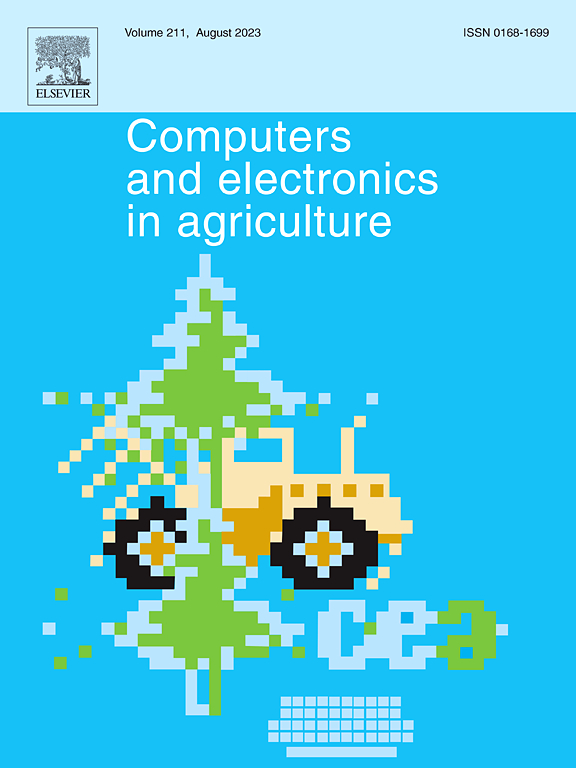田间小麦氮素胁迫的原位分析:拉曼光谱无损快速分析方法
IF 8.9
1区 农林科学
Q1 AGRICULTURE, MULTIDISCIPLINARY
引用次数: 0
摘要
氮是植物生长发育的重要元素,对作物产量有重要影响。缺氮严重损害作物生长,而过量的氮则危害环境。为了解决这一问题,迫切需要一种快速、现场的方法来评估氮胁迫下作物的生理状态。本研究利用拉曼光谱这一无损、快速的分析技术,对不同氮素处理下小麦植株的生理状况进行了评价。这些处理包括最佳施氮、低施氮、过量施氮和零施氮。通过利用拉曼光谱识别植物叶片中代谢物的特征峰并根据峰强度对其进行量化的能力,我们分析了类胡萝卜素、叶绿素、纤维素、木质素和脂肪成分的水平。结果表明,不同氮肥处理下,代谢物峰强度存在显著差异。最佳施氮量促进了代谢物的积累,缺氮导致光合色素和结构成分显著减少。过量的氮导致木质素和纤维素的减少。为了诊断氮胁迫,我们开发了能够准确区分健康植物和氮胁迫植物的分类模型,训练集准确率为99%,交叉验证准确率为92%,预测集准确率为93%。此外,我们区分了不同程度缺氮的小麦植株,最高准确率为78%。当同时考虑缺氮和过量时,最大精度达到58%。本研究提供了一种快速、准确、无损的基于拉曼光谱的田间小麦氮素胁迫分析诊断方法。未来的研究目标是将该方法扩展到其他作物的氮胁迫诊断,并探索其在氮肥管理中的应用。本文章由计算机程序翻译,如有差异,请以英文原文为准。
In-situ analysis of nitrogen stress in field-grown wheat: Raman spectroscopy as a non-destructive and rapid method
Nitrogen, as a vital element for plant growth and development, significantly influences crop yields. Nitrogen deficiency severely impairs crop growth, while excess nitrogen harms the environment. To address this, there is an urgent need for rapid and on-site methods to assess the physiological status of crops under nitrogen stress. In this study, we utilized Raman spectroscopy, a non-destructive and rapid analytical technique, to evaluate the physiological status of wheat plants subjected to various nitrogen treatments. These treatments included optimal, low, excessive and zero nitrogen application. By leveraging Raman spectroscopy’s ability to identify characteristic peaks of metabolites in plant leaves and quantify them based on peak intensity, we analyzed the levels of carotenoids, chlorophylls, cellulose, lignin, and aliphatic components. Our results revealed significant differences in metabolite peak intensity under different nitrogen treatments. Optimal nitrogen application promoted the accumulation of metabolites, while nitrogen deficiency led to a marked decrease in photosynthetic pigments and structural components. Excessive nitrogen caused a reduction in lignin and cellulose. To diagnose nitrogen stress, we developed classification models that accurately distinguished between healthy and nitrogen-stressed plants, achieving a training set accuracy of 99 %, a 5-fold cross-validation accuracy of 92 %, and a prediction set accuracy of 93 %. Furthermore, we differentiated wheat plants with varying degrees of nitrogen deficiency, achieving a maximum accuracy of 78 %. When considering both nitrogen deficiency and excess, the maximum accuracy reached 58 %. This study provides a fast, accurate, and non-destructive analytical method for analyzing and diagnosing nitrogen stress in field wheat based on Raman spectroscopy. Future research aims to extend this approach to the diagnosis of nitrogen stress in other crops and to explore its applications in nitrogen fertilization management.
求助全文
通过发布文献求助,成功后即可免费获取论文全文。
去求助
来源期刊

Computers and Electronics in Agriculture
工程技术-计算机:跨学科应用
CiteScore
15.30
自引率
14.50%
发文量
800
审稿时长
62 days
期刊介绍:
Computers and Electronics in Agriculture provides international coverage of advancements in computer hardware, software, electronic instrumentation, and control systems applied to agricultural challenges. Encompassing agronomy, horticulture, forestry, aquaculture, and animal farming, the journal publishes original papers, reviews, and applications notes. It explores the use of computers and electronics in plant or animal agricultural production, covering topics like agricultural soils, water, pests, controlled environments, and waste. The scope extends to on-farm post-harvest operations and relevant technologies, including artificial intelligence, sensors, machine vision, robotics, networking, and simulation modeling. Its companion journal, Smart Agricultural Technology, continues the focus on smart applications in production agriculture.
 求助内容:
求助内容: 应助结果提醒方式:
应助结果提醒方式:


